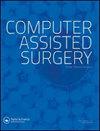The role of the precuneus and posterior cingulate cortex in the neural routes to action.
IF 1.9
4区 医学
Q3 SURGERY
引用次数: 0
Abstract
Neural substrates of action to the object or this specific direct route, however, remain unclear, especially for the connection from the visual pathway to the motor cortex. The study examined this issue by conducting an fMRI experiment, in which two action generation tasks involving pictures of real objects (PA) and the object's nouns (NA) were used, with pictures naming (PN) and covert noun reading (NR) being the control tasks. The result showed that the model predefined for the PCC and precuneus connecting IPL to the posterior-medial frontal cortex dominated over the others (with 0.45 probability), suggesting that the PCC and the precuneus locate at the neural substrates of action to the object. Furthermore, a feasibility study suggests that the neural pathway composed of the V3/MT, precuneus, PCC, and PM (premotor cortex) forms the direct route from perception to action, which also links to the dorsal pathway so that the perception of objects bypasses the semantic ventral pathway and then directly cues actions via the affordance.楔前叶和后扣带皮层在神经通路中的作用。
然而,对物体或这一特定直接通路的作用的神经基质,特别是从视觉通路到运动皮层的连接,仍不清楚。该研究通过功能磁共振成像(fMRI)实验检验了这一问题,实验中使用了两个动作生成任务,涉及真实物体的图片(PA)和物体的名词(NA),其中图片命名(PN)和隐蔽名词阅读(NR)是控制任务。结果表明,PCC和楔前叶连接IPL与后内侧额叶皮层的模型优于其他模型(概率为0.45),表明PCC和楔前叶位于对物体产生作用的神经底物上。此外,一项可行性研究表明,由V3/MT、楔前叶、PCC和PM(运动前皮质)组成的神经通路形成了从感知到行动的直接途径,并与背侧通路相连,从而使物体的感知绕过语义腹侧通路,直接通过功能提示提示动作。
本文章由计算机程序翻译,如有差异,请以英文原文为准。
求助全文
约1分钟内获得全文
求助全文
来源期刊

Computer Assisted Surgery
Medicine-Surgery
CiteScore
2.30
自引率
0.00%
发文量
13
审稿时长
10 weeks
期刊介绍:
omputer Assisted Surgery aims to improve patient care by advancing the utilization of computers during treatment; to evaluate the benefits and risks associated with the integration of advanced digital technologies into surgical practice; to disseminate clinical and basic research relevant to stereotactic surgery, minimal access surgery, endoscopy, and surgical robotics; to encourage interdisciplinary collaboration between engineers and physicians in developing new concepts and applications; to educate clinicians about the principles and techniques of computer assisted surgery and therapeutics; and to serve the international scientific community as a medium for the transfer of new information relating to theory, research, and practice in biomedical imaging and the surgical specialties.
The scope of Computer Assisted Surgery encompasses all fields within surgery, as well as biomedical imaging and instrumentation, and digital technology employed as an adjunct to imaging in diagnosis, therapeutics, and surgery. Topics featured include frameless as well as conventional stereotactic procedures, surgery guided by intraoperative ultrasound or magnetic resonance imaging, image guided focused irradiation, robotic surgery, and any therapeutic interventions performed with the use of digital imaging technology.
 求助内容:
求助内容: 应助结果提醒方式:
应助结果提醒方式:


